Physical Address
304 North Cardinal St.
Dorchester Center, MA 02124
Despite marked improvements in antenatal and perinatal care, perinatal brain injury remains one of the most important medical complications in the newborn resulting in significant handicap later in life. Experimental advances have helped to understand many of the cellular and vascular mechanisms of perinatal brain damage, showing a correlation between the nature of the injury and the maturation of the brain, but effects on long-term circuit formation are just emerging. Early identification of brain injury and appropriate prognostication though remain a major challenge to neonatal care. Different forms of imaging are diagnostic tools that have emerged to detect early brain injury and help predict outcome.
Magnetic resonance (MR) techniques are one of these relatively new diagnostic tools that allow the assessment of the developing brain in detail thanks to their resolving power and their noninvasiveness. Their capacity to provide detailed structural as well as metabolic and functional information without the use of ionizing radiation is unique.
Conventional MR imaging is therefore now widely used for identifying normal and pathologic brain morphology giving objective information about the structure of the neonatal brain during development. Susceptibility-weighted imaging (SWI) with phase postprocessing is particularly useful for detecting intravascular venous deoxygenated blood as well as extravascular blood products. Diffusion-weighted imaging (DWI), , spectroscopy , and functional MR imaging (blood-oxygenation-dependent [BOLD] imaging) are newer MR techniques that complement conventional MR imaging and can indicate some of the pathophysiologic mechanisms occurring during brain injury in the newborn and the postinjury plasticity. This article will focus on the role of the different MR techniques in the study of perinatal brain injury. The specific patterns of brain injury identified by different imaging techniques will be illustrated by case presentations, followed by the discussion of pathophysiologic and neurodevelopmental outcome associated with the described brain lesion. This approach should allow the reader to make the right choice of imaging method at the right time to decide on intervention, withdrawal of care, and accurate prediction of a range of neurofunctional outcomes.
Neonatal brain injury in the term infant is most frequently related to cerebral hypoperfusion and/or hypoxemia followed by reperfusion as the infant is resuscitated, typically shortly after delivery. This is summarized in the term “asphyxia,” progressive hypoxemia, and hypercapnia with significant metabolic acidosis occurring both in the antenatal, intrapartum, and neonatal period. , Perinatal asphyxia may lead to hypoxic-ischemic encephalopathy (HIE) which is the clinically defined condition of disturbed neurologic function in the newborn, characterized by insufficient respiration, depression of tone and reflexes, altered level of consciousness, and often seizures. The subsequent neurological deficits of concern are grouped together under the term of cerebral palsy , , but include different motor deficits, such as spasticity, choreoathetosis, dyskinesia, dystonia, and ataxia. Further cognitive deficits, behavior, memory problems, and seizures might also be the end result of neonatal HIE.
The major varieties of neuropathologies that are found in neonatal HIE are listed in Table 15.1 .
| Major Neuropathological Varieties of Neonatal HIE in the Term Infant | Characteristics of the Usual Insult According to the Pattern of Injury or Pathogenesis of the Injury |
|---|---|
|
|
| Parasagittal cerebral injury (watershed injury) |
|
| Focal and multifocal ischemic necrosis |
|
Selective neuronal necrosis is the most common pathology observed in HIE and refers to necrosis of neurons in a characteristic, although often widespread, distribution. The four basic patterns of the topography of the neuronal injury depend on the severity and temporal characteristics of the insult, and on the gestational age. Thus pontosubicular necrosis occurs more frequently in premature than in term infants and the basal ganglia neurons of the putamen are more likely to be affected in term infants, whereas neurons from the globus pallidus are more frequently affected in premature infants.
The reason why a term infant with hypoxia-ischemia may develop one of the various patterns of selective neuronal necrosis or primarily parasagittal cerebral injury is not entirely clear but might be related to brain stem and basal ganglia sparing reflex, where the blood flow is redirected to basal ganglia, the brainstem, and the cerebellum in case of mild to moderate asphyxia that does not occur in case of severe abrupt hypoperfusion, i.e., in case of a sentinel event like uterine rupture or cord compression.
Pre- or postnatal generalized systemic circulatory insufficiency can also generate focal or multifocal ischemic necrosis.
The occurrence of a neonatal neurological syndrome requires the search for brain injury either from ante-, intra-, or postpartum events. The neurological symptoms of severe HIE are described in Table 15.2 . Important systemic abnormalities (renal, cardiac, hepatic, etc.) related to ischemia accompany the neurological manifestations in most cases but show no relation to outcome.
| Birth to 12 hours | 12–24 hours | 24–72 hours | After 72 hours |
|---|---|---|---|
|
|
|
|
Clinicopathological correlations can be made for the different neuropathological varieties of neonatal HIE in the term infant and are summarized in Table 15.3 .
| Topography of the Major Injury | Neonatal Correlates | Long-Term Correlates |
|---|---|---|
| Selective neuronal necrosis of the diffuse type |
|
|
| Selective neuronal necrosis of cortical–deep nuclear type | Same symptoms except that the tone is usually increased, especially with stimulation |
|
| Selective neuronal necrosis of deep nuclear–brainstem type |
|
|
| Parasagittal cortical cerebral injury |
|
|
| Focal and multifocal brain necrosis (cortical and subcortical) |
|
|
The following four cases of term perinatal asphyxia illustrate the clinical course, the neuroimaging characteristics, and the subsequent neurodevelopmental outcome and will illustrate the role and appropriate timing of MR imaging in the evaluation of the term newborn after perinatal asphyxia.
History : Term pregnancy with signs of fetal distress, cesarean section, low Apgar score, perinatal acidosis (pH 6.99). On day 1, general hypotonia, tonic deviations of eyes, sucking, smacking “subtle seizures.” Normal neurologic exam on day 10.
Neuroimaging studies (see Fig. 15.1 ): Neonatal head ultrasound performed on day 1 is normal. MRI on day 3 reveals no significant signal abnormalities on T2-weighted images and some signal hyperintensities on T1-weighted images especially in the central cortex. DWI shows abnormal signal intensities with reduced apparent diffusion coefficient (ADC) bilaterally in the thalamus and internal capsule. Some discrete areas of reduced ADC are seen in the cortex. A repeat follow-up study on day 10 (see Fig. 15.2 ) shows thalami appearing brighter than normal on T2-weighted images with central white matter of relatively high intensity, often difficult to judge as normal or abnormal and might require repeat scanning to detect gliosis in the white matter later.
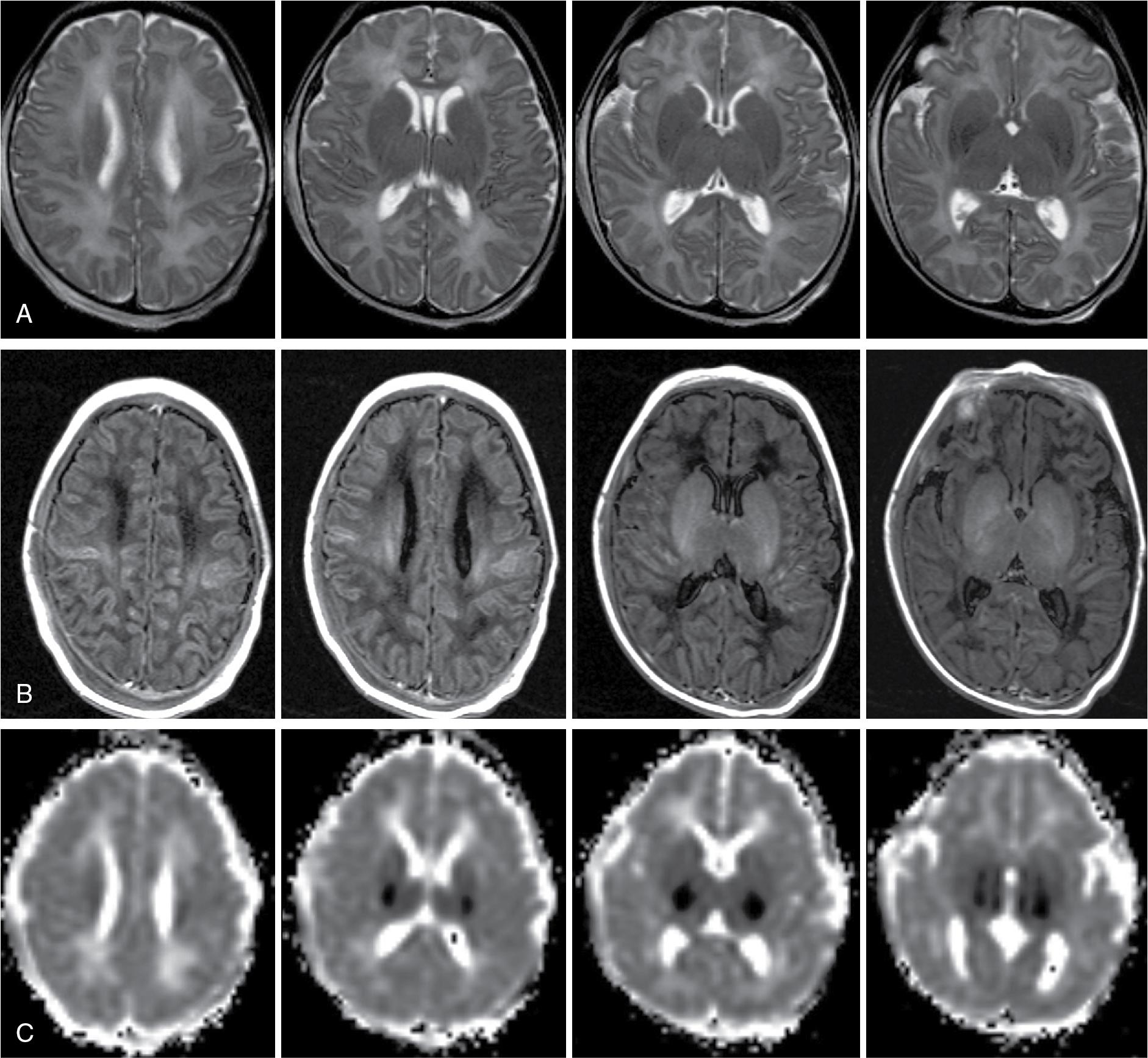
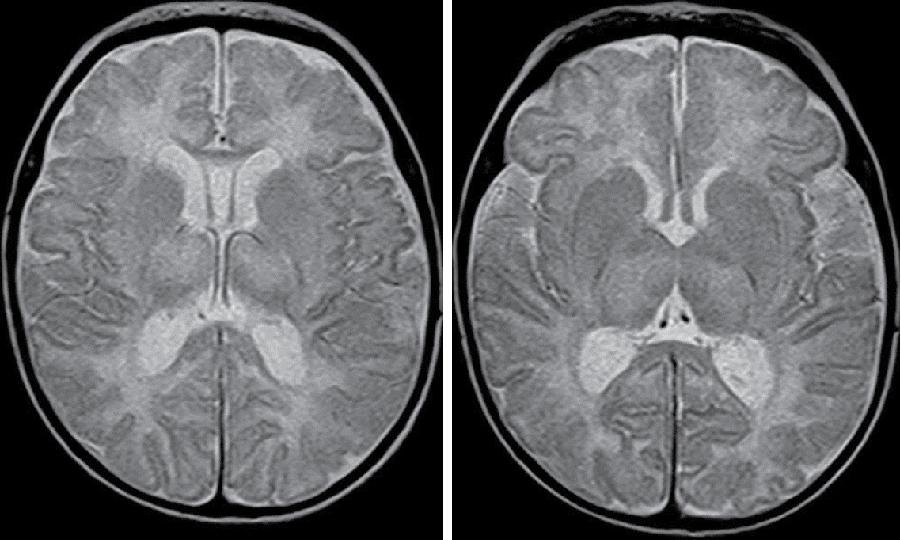
Clinical correlates in the neonatal period : This child developed signs of moderately severe impairment of bilateral hemispheres which characteristically results in diffuse hypotonia. He also presented with neonatal seizures of the “subtle” type which are thought to result from diffuse cortical injury, and could be relation to the discrete areas or reduced ADC seen in the cortex. The normalization of the neurological examination at 10 days of life can be viewed as a positive prognostic sign but does not preclude developmental issues.
Long-term clinical correlates : Ultimately, he developed signs of moderate spasticity especially in the upper limbs, but was able to walk unaided at the age of 3 years with a certain degree of truncal hypotonia. His fine motor skills were delayed due to dystonic movements of the arms. The onset of dystonia started around the age of 12 months and became more prominent with time. He had no major cognitive deficits. The mild spasticity is explained by the involvement of the central white matter and perirolandic cortex (seen best on DWI and T1 at day 3) and the dystonia is the result of the thalamo-putaminal lesions. The relatively good functional outcome of this patient was in part predictable from the normalization of his neurological exam at 10 days of life. The diagnosis still is dystonic CP with a spastic component (GMFCS level II), so unaided walking but needs help for stairs.
History : Term pregnancy with signs of fetal distress, emergency cesarean section for uterine rupture, meconium aspiration, low Apgar score (1/3/5), perinatal acidosis (pH 6.84). Initial general hypotonia, then hypertonicity, no seizures.
Neuroimaging studies : Neonatal head ultrasound performed on day 1 is normal. MRI on day 1 reveals no significant signal abnormalities on T2- and T1-weighted images and on DWI. Single voxel 1 H-MRS performed on basal ganglia reveals elevated lactate (Lac) resonance at 1.3 ppm with no loss of N -acetylaspartate (NAA) (see Fig. 15.3 ). Follow-up MRI at day 10 shows bilateral thalami and putamen appearing hyperintense on T2-weighted images with clear distinction on proton density images with no cortical signal abnormalities (see Fig. 15.3 ). On T1-weighted images hyperintensities in this region can be confounded with hyperintensities due to myelination (see Figs. 15.3 and 15.4 ). 1 H-MRS now shows normalization of lactate and reduction of NAA ( Fig. 15.4 )
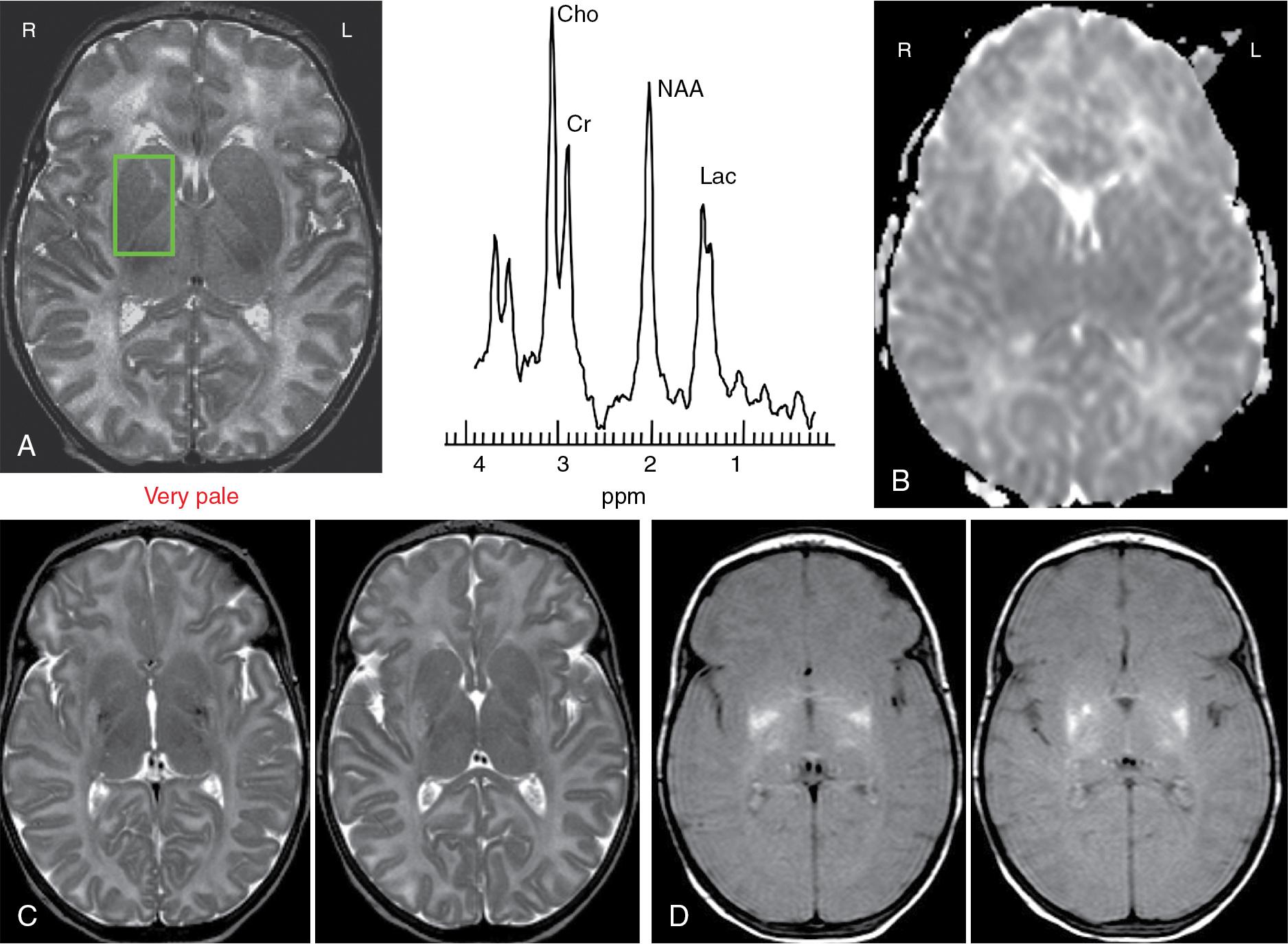
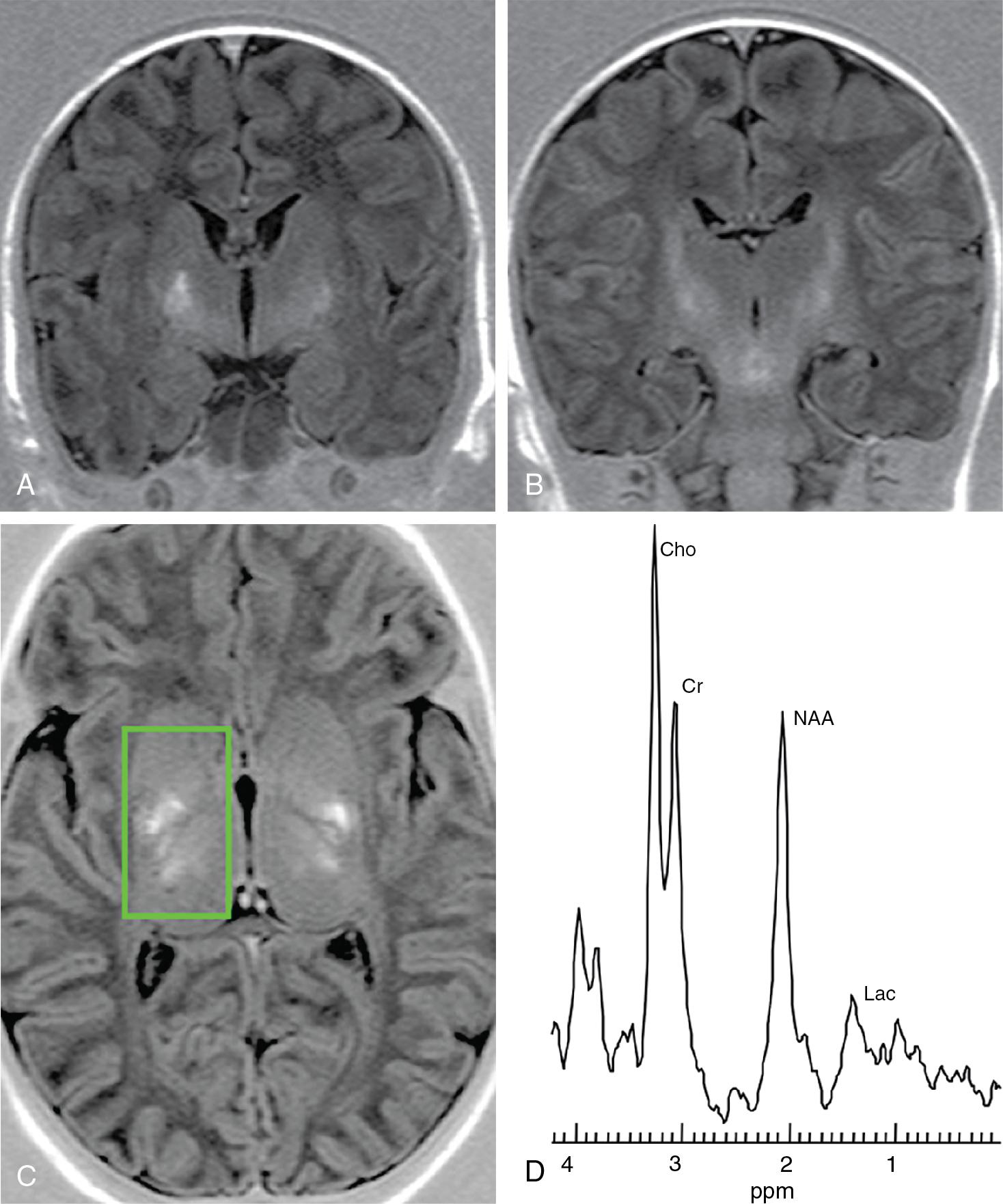
Clinical correlates in the neonatal period : After a brief period of hypotonia, corresponding most likely to the bilateral involvement of the reticular activating system in the diencephalon, this child developed rapidly the characteristic hypertonia associated to basal ganglia lesions and due to the involvement of the extrapyramidal system. It is interesting to note that no seizures were observed, most likely in relation to the fact that there were no cortical lesions.
Long-term clinical correlates : This child developed striking truncal hypotonia and severe dystonic posturing of the upper extremities limiting severely her motor development, although there was no spasticity. She is unable to walk unaided. Her receptive language competence is normal but her expressive language is noninterpretable and she uses vocal synthesis device. Her cognitive functions are however preserved. The diagnosis is severe CP of the dystonic type with a GMFCS IV.
History : Term pregnancy with intrauterine growth restriction, fetal distress, cesarean section, meconium aspiration perinatal acidosis, persistent pulmonary hypertension (pH 7.08).
Neuroimaging studies : Neonatal head ultrasound performed on day 1 is normal. MRI on day 1 reveals no significant signal abnormalities on T2- and T1-weighted images and standard DWIs reveal no striking signal abnormality ADC values measured in the left basal ganglia (ADC 0.8 mm 2 /ms) and central white matter (ADC 0.8 mm 2 /ms), respectively reveals markedly reduced ADC values compared to normal term neonates (1.0–1.2/1.4) (see Fig. 15.5 ). 1 H-MRS performed on basal ganglia reveals elevated lactate resonance at 1.3 ppm with no loss of NAA. Follow-up MRI shows marked T2 signal abnormalities in the basal ganglia with involvement of the left internal capsule with extension into the central white matter in a parasagittal distribution (see Fig. 15.6 ).
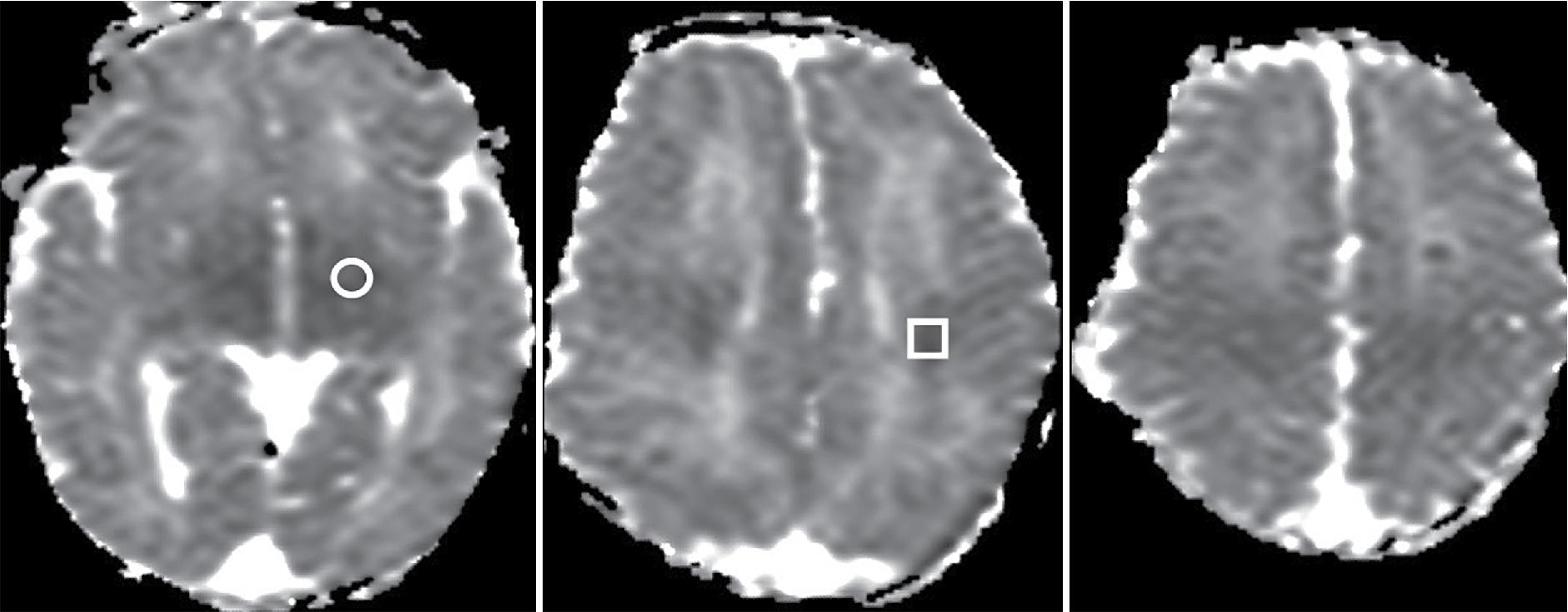

Clinical correlates in the neonatal period : This infant did not develop striking neurological abnormalities in the neonatal period. The only symptom was a moderate hypotonia and some weakness in the upper extremities.
Long-term clinical correlates : Development of marked right upper extremity palsy at the age of 6 months. The child did not reach for objects with the right hand and exhibited a spastic position of the right arm during leg movements. In the ventral position, she was unable to elevate her right arm. These impairments were in relation with the lesions of the left internal capsule. Later, at age 18 months, she showed signs of hyperreflexia in all four limbs as a result of the bilateral white matter lesions, but spasticity predominated on the right side, as a sequela of the unilateral left internal capsule lesion. Her cognitive performances were mildly delayed. She was able to walk unaided at the age of 2 years. The diagnosis is spastic CP GMFCS level II, predominating on the right side.
History : Term pregnancy with uterine rupture at delivery. Perinatal resuscitation with Apgar scores at 0/0/3 and severe perinatal acidosis. On day 1, development of a moderate HIE with lethargy and hypotonia. Efforts in arousing the infant resulted in hypertonia and jitteriness. Spontaneous movements were diminished. Convulsions appeared rapidly.
Neuroimaging studies : Neonatal head ultrasound performed on day 1 is normal. MRI on day 2 reveals no significant signal abnormalities on T2- and T1-weighted images. DWIs reveal abnormally high signal corresponding to reduced ADC in ADC maps (not shown) bilaterally in putamen and thalami as well as in the perirolandic cortex (see Fig. 15.7 ). 1 H-MRS performed in basal ganglia reveals elevated lactate resonance at 1.3 ppm with no loss of NAA (not shown). Follow-up MRI at 17 days shows marked T2 signal abnormalities in the basal ganglia and alteration of the perirolandic cortex bilaterally visible both on proton density images as well as on T2-weighted images (see Fig. 15.7 ). At 2 months of age, additional atrophy and delay in myelination is present (see Fig. 15.8 ).
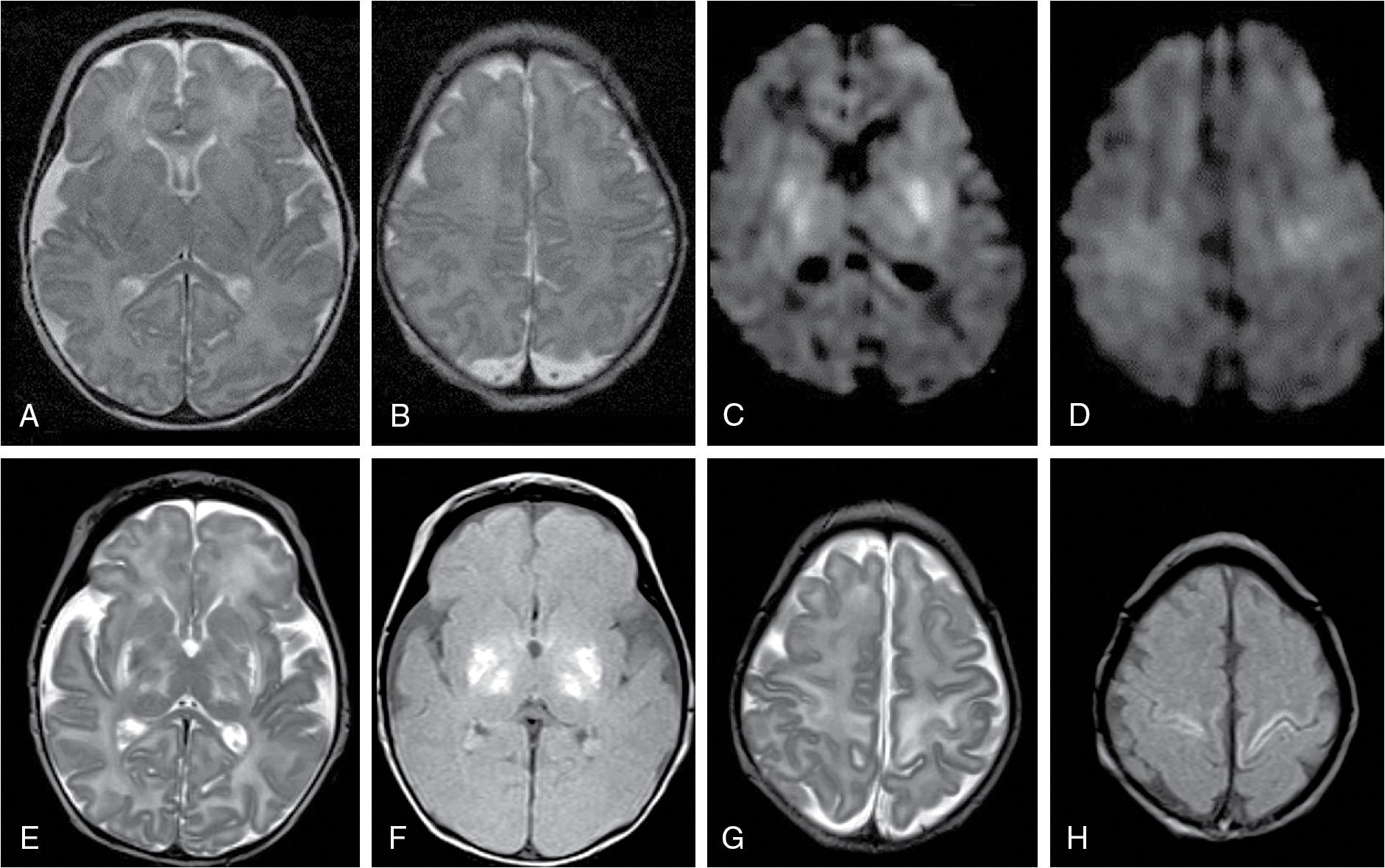
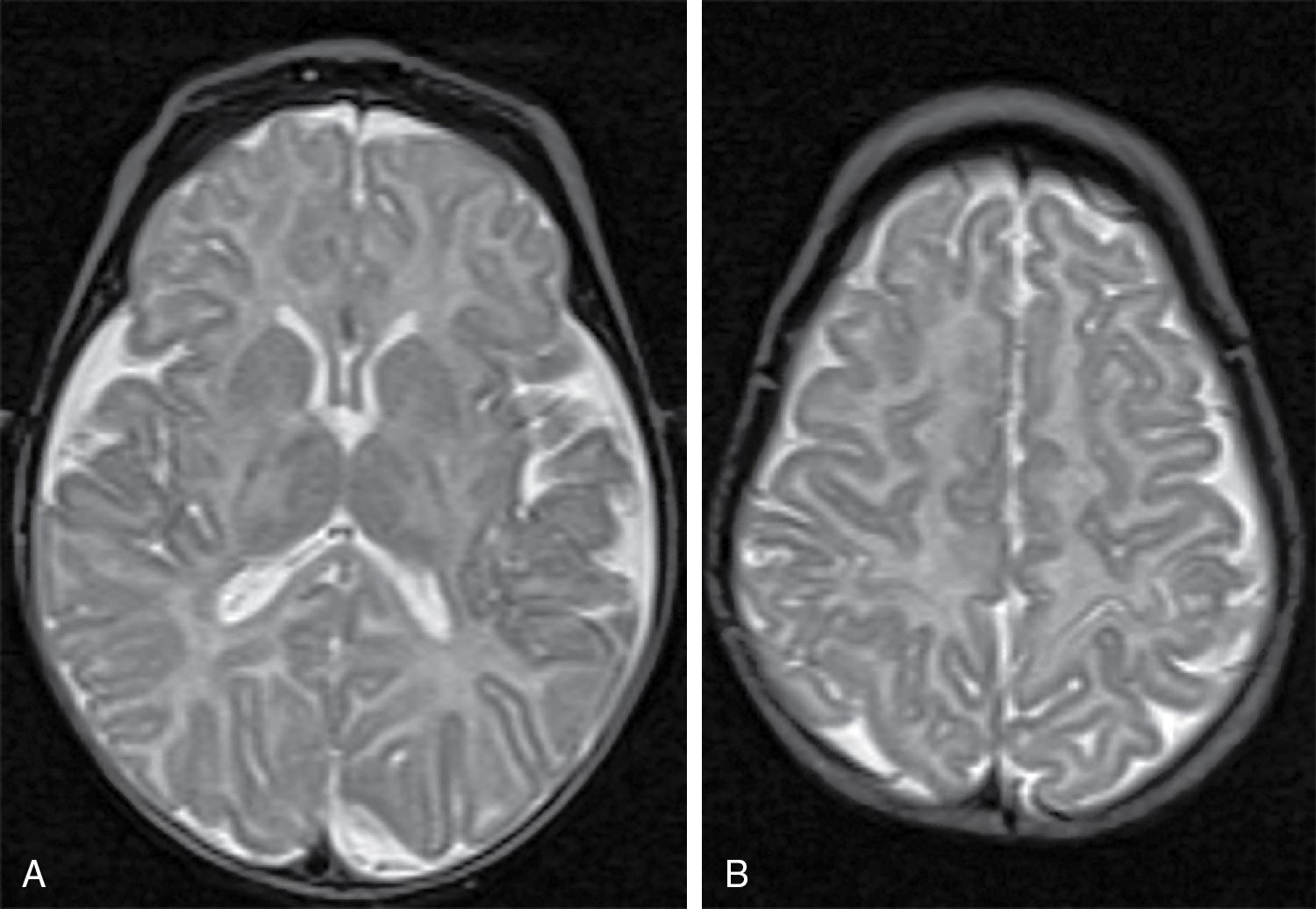
Clinical correlates in the neonatal period : The infant presented with neonatal seizures and a disturbed level of consciousness which reflected the bilateral cortical lesions.
Long-term clinical correlates : The child developed a severe spastic quadriplegia related to the injury in the perirolandic cortex. Additionally, dystonia started around the age of 12 to 18 months. This extrapyramidal syndrome was the result of the additional basal ganglia lesions. The child is thus severely disabled and unable to walk unaided (GMFCS level IV–V). However, the cognitive impairment is mild and she uses vocal synthesis for communication.
History : Term pregnancy with persistent signs of fetal distress, cesarean section, low Apgar score with meconium aspiration, and cardiorespiratory resuscitation.
On day 1, general hypotonia, tonic deviations of eyes, sucking, smacking “subtle seizures,” and electroencephalographic status epilepticus.
Neuroimaging studies : Neonatal head ultrasound performed on day 1 shows small ventricles and increased parenchymal echogenicity, suggestive of an insult prior to delivery. MRI performed on day 7 shows extensive signal intensity changes in the white matter with the cortex roughly isointense with white matter, especially posteriorly on T2- and T1-weighted images and apparent sparing of the thalami and basal ganglia, except for the pulvinar (see Fig. 15.9 A, B). Also note the swollen mammillary bodies with increased signal intensity on T2 (see Fig. 15.9 A). On DWI, markedly decreased ADC in both cortex, white matter (0.70), and basal ganglia (see Fig. 15.9 C). Follow-up MRI 6 weeks later shows evolution into multicystic encephalomalacia with loss of both hemispheric gray and white matter and severe ex vacuo hydrocephaly (see Fig. 15.9 D, E).

Clinical correlates in the neonatal period : the generalized hypotonia and the seizures reflect the bilateral extensive cortical injuries. The status epilepticus which is not uncommon in full-term asphyxia is the sign of the severity of the insult.
Long-term clinical correlates : The child developed a severe spastic quadriplegia with cognitive impairment and microcephaly. Spasticity was a major issue. The seizure disorder remained active during the first months of life. The EEG remained severely depressed indicating diffuse cortical necrosis. The diagnosis is severe spastic CP (GMFCS level V) and severe intellectual disability.
Neonatal sonography is still the only bedside technique to image the neonatal brain. In term perinatal asphyxia and HIE, the most typical findings in the acute phase are represented by poor differentiation of cortical sulci and diffuse increase of parenchymal echogenicity and slit-like ventricles. These features can be primarily related to diffuse cerebral edema. Injury in the basal ganglia can lead to hyperechogenic basal ganglia, but these abnormalities take time to develop and are usually first seen 48 to 72 hours after birth. When echogenicity develops in the thalami as well as the basal ganglia, a “four column” pattern can be recognized. This pattern has been shown to be predictive of poor outcome , and an echolucent line running between the thalami and basal ganglia corresponding to the posterior limb of the internal capsule has been shown to be predictive of poor outcome. But many early ultrasound scans in neonates with HIE lesions are normal or nonspecific, as illustrated in the cases shown. Ultrasound examinations can be considered as a first-step technique that will exclude significant hemorrhage, periventricular calcifications, overt brain malformation, or signs of well-established injury dating the insult before birth. However, accurate assessment of brain injury should be done with an MRI study.
MR has become the technique of choice to evaluate the hypoxic-ischemic brain both in adults and in the newborn. Additional MR imaging techniques, such as the use of DWI, SWI, and MR spectroscopy, have further improved the MR capability to investigate the neonatal brain. Generally, to increase the signal-to-noise ratio, a higher field magnet (1.5–3 T) should be used, allowing for high-resolution imaging and increased sensitivity for spectroscopy.
The basic information in conventional MR imaging is represented by T1- and T2-weighted images. Proton density and FLAIR images help illustrate brain lesions with slightly different contrast than T1- and T2-weighted images. A neonatal MR imaging protocol should provide good quality T1- and T2-weighted images with a maximum field of view of 16 to 18 cm and a slice thickness of 2 mm or less. Due to increased water content of the neonatal brain with longer T1 and T2 relaxation times, the repetition time (TR) should be increased in both T1-weighted and T2-weighted imaging sequences. Typically MR sequence parameters for T1-weighted images should include an increased TR to 800 ms and a TR above 5000 ms with an echo time (TE) of 125 to 150 ms for T2-weighted imaging. , To compensate for a long TR, the echo-train-length can be increased.
As shown in the three cases previously with a history of acute perinatal asphyxia, selective involvement of areas with advanced maturation and higher energy demands, i.e., the putamen, ventrolateral thalami, and perirolandic cortex, are particularly vulnerable. Characteristic changes representing selective neuronal necrosis in these areas on T1-weighted images are T1 hyperintensities, which become apparent 3 to 7 days after the insult. These T1 hyperintensities might represent cellular reaction of glial cells and macrophages containing lipid droplets and/or some mineralization of necrotic cells. Some difficulties in identifying these lesions arise from the fact that early myelination shows the same imaging characteristics. T1 hyperintensities in the internal capsule due to beginning myelination need to be differentiated from lateral thalamic lesions and lesions in the putamen. Often the posterior limb appears swollen and has lost its normal T1 hyperintensity/T2 hypointensity, which has a bad prognostic value and is associated with development of cerebral palsy. These T1 changes are not apparent till the end of the first week and most infants are now scanned on the day following rewarming, which is often too early to see these changes in the PLIC. On T2-weighted images, thalami might appear slightly hyperintense in the acute phase (see Case 1 ) but these signal changes tend to be very difficult to detect. T2 hyperintensities become more apparent at a later stage, illustrated also by well-defined lesions on proton-density images (see Case 2 ). Evolution of these lesions is marked by progressive atrophy of the involved area (i.e., putamen, thalami, rolandic cortex) with persistent T2 hyperintensity and possible cavitation.
Of note, similar lesions in the bilateral thalami, lentiform nucleus, and globus pallidum can be detected also in premature infants with documented severe anoxic insults, most frequently associated with the typical periventricular white matter injuries.
Isolated parasagittal injury refers to a lesion of the cerebral cortex and the subcortical white matter with a defined distribution, i.e., parasagittal, superomedial aspects of the cortical convexities, usually bilateral but often asymmetric in its extension. , During the acute phase, the cortex might show increased T1-weighted signal intensity or little abnormality on conventional MR imaging (see Fig. 15.10 ). On the T2-weighted sequence, loss of the cortical ribbon is best seen. Chronic changes involve cortical thinning and atrophy and less often subcortical cysts.

Case 5 shows another form of brain injury associated with HIE. Early on (<2 days), conventional MRI is characterized by a diffuse T1 hypointensity and T2 hyperintensity involving both the cortex and the subcortical white matter but sparing the cerebellum and the more basal structures of the medulla (see Fig. 15.9 ). Late intrauterine generalized prolonged systemic circulatory insufficiency is probably at the origin of these lesions, which evolve into severe cortical atrophy with cavitation and are invariably associated with a severe neurological syndrome.
Become a Clinical Tree membership for Full access and enjoy Unlimited articles
If you are a member. Log in here